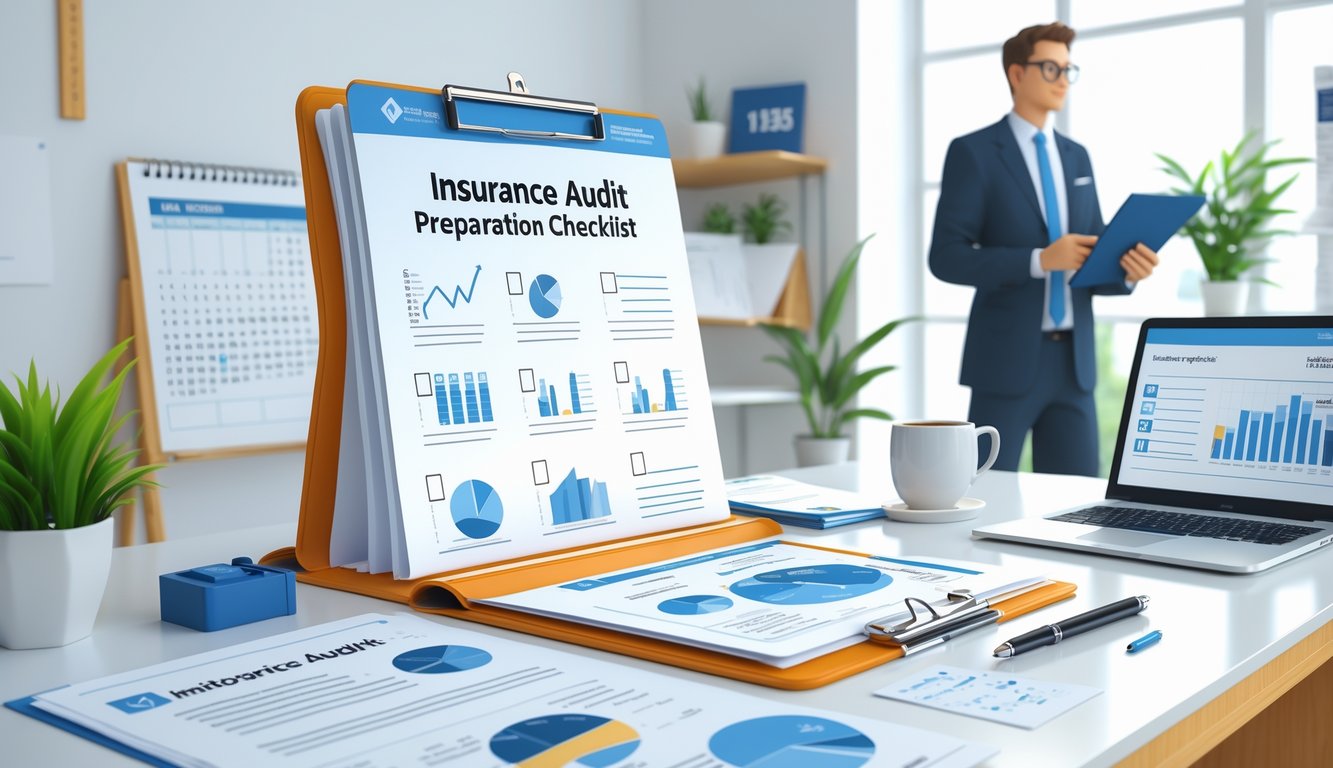Getting ready for an insurance audit can feel like a lot, but the right checklist really lightens the load. A solid insurance audit preparation checklist helps you gather what you need, review your policies, and check compliance before the auditors show up. You’ll save yourself time and skip a lot of stress when the audit actually happens.

Insurance audits check whether your business follows the rules and pays the right premiums.
The auditor will look at your records, payroll, and how your business operates.
When you get ready in advance, you can answer their questions faster and keep things moving.
This guide covers each step you’ll need to prepare for your insurance audit.
You’ll see what documents to collect, how to keep your records in order, and what the process usually looks like.
Key Takeaways
- A clear checklist helps you organize all documents before the audit
- Good preparation cuts down on audit time and helps you meet insurance requirements
- Keeping records organized and knowing the process makes the audit smoother
Insurance Audit Preparation Checklist

You’ll need three core things: all current policy documents, insurance certificates that meet requirements, and financial records that are up to date.
These make up the foundation of a successful audit.
Gathering Essential Policy Documents
Collect all your active insurance policies before the audit.
That means general liability, workers’ comp, property, and professional liability.
Policy Documents You’ll Need:
- Current policy declarations
- Policy endorsements or amendments
- Premium payment records
- Claims history reports
- Renewal notices
Set up a master file for each policy type.
Add the policy number, dates, and coverage limits so you can find details fast.
If you’re missing something, reach out to your insurance agent or carrier.
Ask for copies at least a month before your audit.
Store digital copies in a secure cloud system.
That way, you can pull up documents quickly when you need them.
Verifying Certificates of Insurance
Make sure your certificates of insurance have the right coverage details and up-to-date effective dates.
Old or incorrect certificates can slow down your audit.
Check each certificate for:
- Policy numbers that match your actual policies
- Coverage limits that are current
- Effective dates with no gaps
- Additional insured listings that are complete
If you spot mistakes, ask your agent for new certificates.
Most carriers can send updates in a day or two.
Sort certificates by policy type and expiration date.
It’s just easier to keep track that way.
Organizing Payroll and Financial Records
Accurate payroll records matter a lot for workers’ comp audits.
You’ll need to show detailed employee info and wage data.
Key Financial Docs:
- Quarterly payroll reports
- Tax forms (941, 940, W-2s)
- Independent contractor agreements
- Subcontractor certificates of insurance
- Job cost records by classification
Split payroll data by employee classification codes.
Each one has its own premium rates, so double-check for accuracy.
Be sure to include overtime, bonuses, and commissions in your wage totals.
These can change your final premium.
Keep records sorted by quarter and year.
Auditors can get through them faster, and you’ll spend less time answering questions.
Ensuring Compliance and Final Steps

You’re almost done once you check employee classifications, look for coverage gaps, and talk with your insurance provider.
These last steps help protect your business and keep your premiums accurate.
Reviewing Employee Classification Accuracy
Employee classification mistakes can cost you in premium adjustments and penalties.
Check every worker’s status before your audit.
Full-time employees need to be classified by their actual hours and job duties.
Don’t let seasonal workers get mixed up with permanent staff.
Independent contractors need special attention too.
Make sure you have 1099 forms and contracts that spell out their relationship to your company.
Here’s a quick checklist:
- Job duties match the right code
- Hours worked fit the employment status
- You have the right documentation for each worker
- Payroll records back up the classifications
Subcontractors need to show valid certificates of insurance.
If you’re missing those, you might end up paying premiums for their work.
Compare your payroll records with your original policy application.
If job duties or employee counts changed, document and report it.
Identifying Coverage Gaps
Coverage gaps can leave your business open to risk and make audits trickier.
Take a close look at your current policies and see if they match what your business actually does.
Match your business activities to your policy coverage.
If you’ve added services or grown, your policy might not cover everything.
Check for gaps in these areas:
- New equipment or machinery
- Extra business locations
- Changes in seasonal workforce
- Subcontractors who don’t have proper insurance
Professional liability coverage should fit your current services.
Tech companies, for example, often need more coverage as they grow.
Property coverage should reflect what your assets are worth now.
If you’ve bought new equipment or upgraded your facility, your coverage limits might be too low.
Read your policy’s exclusions carefully.
Knowing what’s not covered keeps you from getting caught off guard during the audit.
Coordinating With Your Insurance Provider
Good communication with your insurance provider keeps the audit process smooth.
Set up a pre-audit meeting to go over your documentation.
Give complete records to your insurance rep before the audit.
Include payroll, employee classifications, and any business changes.
Ask questions about your coverage and the audit process.
Knowing what to expect helps you get ready and avoid hiccups.
A few helpful steps:
- Schedule the audit for a time that works for you
- Pick someone to be the primary contact
- Set up a workspace for the auditor
- Gather everything the auditor will need ahead of time
Keep records of all communication with your provider.
Save notes from calls, emails, and meetings about your audit.
Check premium calculations when you get your audit results.
If something doesn’t look right, ask questions.
Your insurance provider should help with classification questions and fix any problems before they get expensive.
Frequently Asked Questions

Insurance audits have specific documentation, prep steps, and calculation methods depending on your policy.
Knowing what’s needed helps you stay compliant and keep your premiums accurate.
What documents are typically required for conducting an insurance audit?
You’ll need to show payroll records, general ledger entries, and tax returns for the audit period.
Workers’ comp audits need payroll broken down by job classification.
Auditors will also ask for 1099 forms for independent contractors and subcontractors.
Keep certificates of insurance from any subcontractors who worked for you.
Financial statements and profit and loss reports help confirm your business operations.
Sometimes, auditors will ask for sales records and invoices to check revenue.
How can a company effectively prepare for a general liability insurance audit?
Sort your records by policy period before the audit.
Make a file with everything the auditor requested, in order by date.
Read your policy to see what triggers the audit and what info they’ll want.
Most general liability audits focus on sales, payroll, and your business activities.
Schedule the audit when people who know the business are available.
Pick one person to work with the auditor so things don’t get mixed up.
In what ways do gross sales figures impact a general liability audit?
Your premium calculation usually depends on your total sales or revenue for the policy period.
More sales often mean higher premiums since there’s more risk.
Auditors check your sales numbers against your financial records and tax returns.
They look for consistency between what you reported and what you actually did.
Some policies don’t count certain sales toward the premium.
Know which ones to avoid paying too much.
What steps should be taken after an insurance policy cancellation to prepare for a potential audit?
Keep all records from the policy period, even after cancellation.
Insurance companies can still audit cancelled policies.
Figure out if you’re owed a return premium based on your actual exposures.
Document any changes in your business that affected your risk.
Let your insurance company know right away about big changes during the policy period.
That includes closing the business, cutting staff, or changing operations.
What are the key components to include in an internal audit checklist for an insurance company?
Your checklist should verify all policy info and coverage details.
Review claim files to make sure documentation and reserves are in order.
Check underwriting files for proper risk assessment and pricing.
Make sure all required forms and endorsements are attached to policies.
Check that you’re following state rules and company procedures.
Don’t forget to review agent licensing and commission calculations.
How is the premium basis for a workers’ compensation audit determined?
Your workers’ compensation premiums depend on your actual payroll for each job classification.
Every classification comes with its own rate per $100 of payroll.
Auditors check out your payroll records and make sure the wages paid to employees match up with their job classifications.
They also look at what your team actually does to see if everyone’s in the right category.
When it comes to overtime, you usually include those wages at straight-time rates for figuring out your premium.
Executive officer payroll can get tricky, since your state might set minimum and maximum limits.






